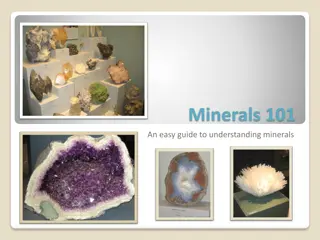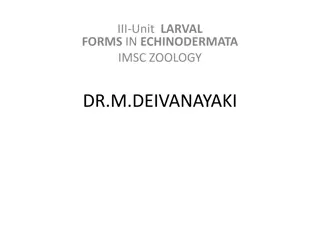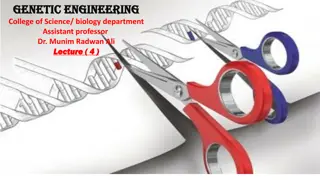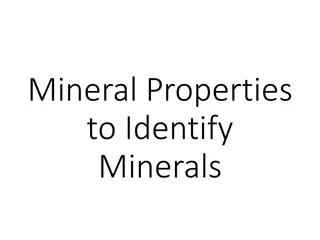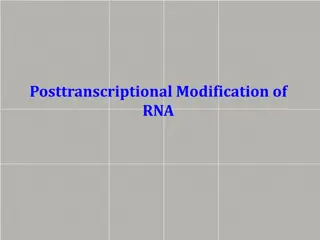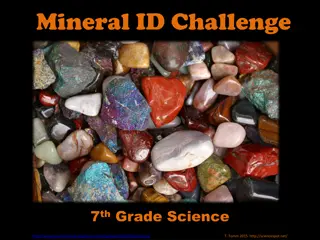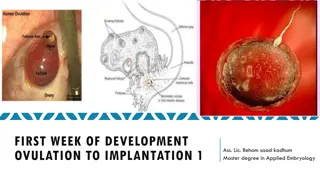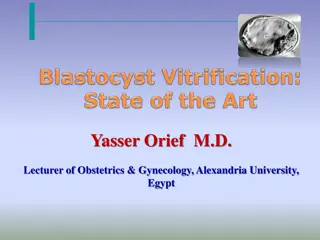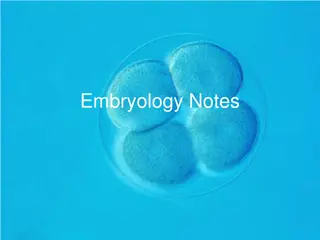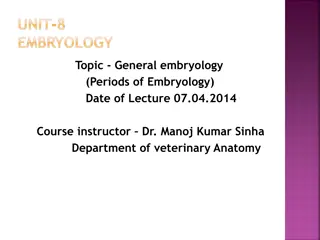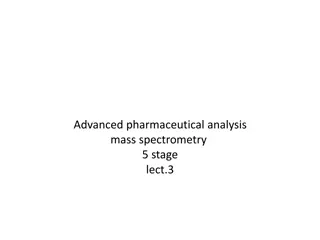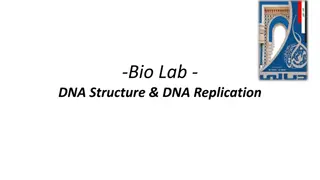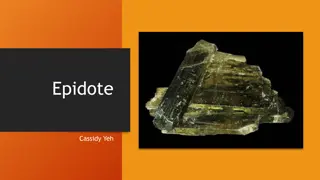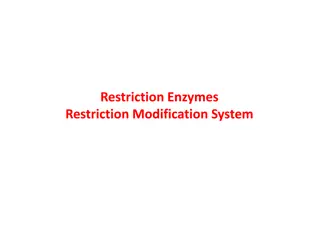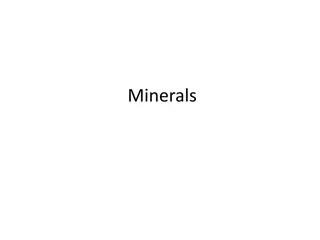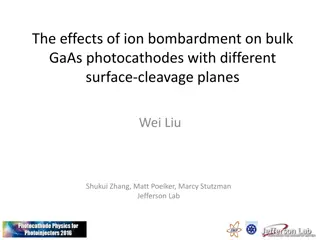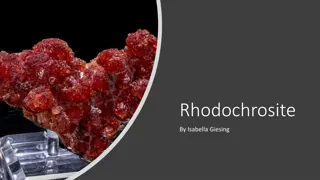Understanding Liver Function Tests in Cholestatic Injury
Cholestatic liver disease affects Alkaline Phosphatase (ALP) and bilirubin levels, indicating bile duct damage. GGT and 5'-Nucleotidase help differentiate hepatobiliary vs. bone origin of ALP elevation. ALP is produced by bile duct epithelium and can be normal in acute biliary obstruction. GGT and N
1 views • 33 slides
Understanding Cleavage in Zygote: Patterns, Types, and Laws
Cleavage is the division process in a zygote that lays the foundation for cellular differentiation. It involves specific patterns like radial, bilateral, and spiral cleavage, with determinate or indeterminate fate of blastomeres. Various laws govern cleavage, including Sach's, Hertwig's, and Balfour
9 views • 24 slides
Understanding Minerals: A Comprehensive Guide
Earth's crust is composed of rocks made up of different minerals, which are naturally occurring, inorganic solids with distinct atomic structures and chemical compositions. Minerals exhibit properties like solidity, natural occurrence, inorganic nature, fixed composition, and crystal form. Identifyi
2 views • 20 slides
Larval Forms in Echinodermata: A Study of Development Stages
Echinoderms, as deuterostomes, exhibit radial and indeterminate cleavage. Their larvae undergo metamorphosis to become adults through various stages. Different classes of echinoderms have distinct larval forms, such as Bipinnaria, Brachiolaria, Auricularia, and more. These larvae display bilateral s
0 views • 8 slides
Understanding Party Systems in Comparative Politics
Parties in comparative politics play a crucial role in deepening democracy, connecting political society with the State, and maintaining accountability. The definition of a party can be categorized based on normative, motivational behavior, and operational perspectives. The development of party syst
0 views • 16 slides
Insights into Enzymes in Genetic Engineering
Discover the role of enzymes like Polynucleotide Phosphorylase, Deoxyribonuclease, and Phosphatase in genetic engineering processes. Learn how these enzymes regulate mRNA processing, DNA cleavage, and phosphate group cleavage, crucial for various applications in biotechnology.
0 views • 13 slides
Understanding Physical Properties for Mineral Identification
Explore the key physical properties used to identify minerals, including color, streak, hardness, cleavage, fracture, luster, and density. Learn how these properties play a crucial role in mineral identification and how to apply them effectively.
0 views • 26 slides
Posttranscriptional Modification of RNA Overview
A primary transcript is the initial RNA copy of a transcription unit, subject to posttranscriptional modifications like cleavage and further alterations to form functional tRNAs, rRNAs, and mRNAs. In eukaryotic cells, pre-rRNAs and pre-tRNAs undergo processing by ribonucleases to yield mature RNA sp
0 views • 12 slides
Zymogens and Ribozymes: An Overview of Inactive Enzyme Precursors
Zymogens, such as trypsinogen and pepsinogen, are inactive enzyme precursors that are activated through specific cleavage in various biological environments. Understanding the activation process of zymogens sheds light on how enzymes are regulated and function in the body.
0 views • 17 slides
Geology Test Review: Rocks and Minerals
This review covers the identification of rocks as igneous, sedimentary, or metamorphic, along with definitions and properties of minerals like cleavage, crystal structure, streak color, and more. It also discusses the classification of rocks as foliated or nonfoliated. Prepare for your geology test
2 views • 112 slides
Alternative Reproductive Techniques in Fertility Treatments
Alternative reproductive techniques such as Gamete Intra-Fallopian Transfer (GIFT) offer options beyond traditional in vitro fertilization for women facing certain infertility challenges. GIFT involves transferring washed sperm and harvested ova to the fallopian tube via laparoscopy, allowing fertil
0 views • 13 slides
Mineral Identification Challenge for 7th Grade Science Students
Engage in a Mineral Identification Challenge where 7th-grade students will explore various minerals using color, streak, luster, transparency, texture, composition, density, crystal shape, cleavage/fracture, hardness, and special properties. Students will rotate through different stations, perform t
0 views • 11 slides
Overview of the First Week of Development from Ovulation to Implantation
The first week of development after ovulation involves key processes like fertilization, cleavage, and blastocyst formation. It begins with the maturation of the primary oocyte in the follicle, leading to ovulation and potential fertilization. During this period, hormonal changes in the ovarian cycl
0 views • 21 slides
Advantages of Blastocyst Transfer in Assisted Reproduction
Blastocyst transfer in assisted reproduction offers several advantages, including improved embryo selection, better synchronization with the female endometrium, reduced uterine contractions, and higher implantation rates. It also allows for cleavage stage embryo biopsy, decreases the risk of multipl
0 views • 34 slides
Embryology Notes: Development from Fertilization to Gastrulation
Embryology is the study of the development of multicellular animals starting from fertilization when the sperm fertilizes the egg and forms the zygote. This initiates a series of events such as cleavage, morula formation, blastula development, and gastrulation, where three embryonic tissue layers ar
0 views • 24 slides
Embryology: Stages of Development and Gestation Period in Different Animals
Embryology covers the Germinal, Embryonic, and Fetal stages of development in animals, highlighting processes like cleavage and formation of morula. Additionally, it provides insights into the gestation periods of various animals ranging from cows and mares to humans and elephants, each with its uni
0 views • 16 slides
Understanding Mass Spectrometry in Pharmaceutical Analysis
Delve into the intricacies of mass spectrometry as applied to pharmaceutical analysis, exploring the fragmentation processes, allylic cleavage in alkenes and alkynes, and the characterization of aromatic hydrocarbons. Discover how mass spectrometry aids in identifying and analyzing various compounds
0 views • 31 slides
All About Arfvedsonite: Rare Mineral Formation and Properties
Arfvedsonite is a rare mineral that is only formed in iron-rich igneous intrusions associated with nepheline syenites and pegmatites. Discovered in 1823 and named after Swedish chemist Johan Arfwedson, it has a distinctive chemical formula and structure as an amphibole mineral. Its physical properti
0 views • 9 slides
Understanding DNA Structure and Replication
Discover the key aspects of DNA, including its structure as a nucleic acid polymer composed of nucleotides and the process of DNA replication. Learn about the double helix structure, base pairing rules, and the semi-conservative replication mechanism. Explore how DNA is synthesized in a 5 to 3 direc
0 views • 18 slides
All About Epidote: Physical, Chemical, and Optical Properties
Epidote, a silicate mineral, is a rock-forming mineral with a crystal structure consisting of isolated and paired silica tetrahedra. It is found in rocks like epidosite and unakite, displaying colors of yellowish-green, green, brownish-green, or black. This mineral has a vitreous luster, a hardness
0 views • 11 slides
Understanding Restriction Enzymes: The Key Players in DNA Manipulation
Restriction enzymes play a crucial role in cutting DNA molecules at specific points, allowing for precise genetic manipulation. This system involves host-controlled restriction and modification mechanisms to defend against foreign DNA, ensuring DNA integrity. Endonucleases recognize specific sequenc
0 views • 17 slides
Understanding Minerals: Properties and Identification
Minerals are naturally occurring solid inorganic substances with definite compositions and structures. They are classified based on physical and chemical properties. This content discusses the definition of minerals, the conditions that classify gold as a mineral, distinguishing mineral characterist
0 views • 29 slides
Ion Bombardment Effects on GaAs Photocathodes
Examining the impact of ion bombardment on bulk GaAs photocathodes with different surface-cleavage planes. Ion back-bombardment in photo-gun setups is a significant factor limiting the operating lifetime of photocathodes. Investigation includes H-ions implantation into GaAs, experimental apparatus d
0 views • 14 slides
Life Cycle of Ascaris lumbricoides in Human Host
Ascaris lumbricoides, commonly known as roundworm, is a human parasite found in the intestine. The life cycle involves copulation, egg development, and infection of a new host through ingestion of eggs. It does not require an intermediate host. The larval stages undergo migration within the body. Th
0 views • 14 slides
All About Rhodochrosite: Properties, Uses, and Locations
Rhodochrosite is a mineral with various properties such as pink, yellow, grey, and brown color variations, perfect cleavage, and a Mohs hardness of 3.5 to 4. It is used as an ore of manganese, a gemstone, and an ornamental stone. Rhodochrosite is found in locations like Argentina, Africa, Montana, R
0 views • 17 slides
Political Cleavages in Post-Colonial Societies: Social-Nativism vs. Social-Federalism
This lecture explores the shifting political cleavages in post-colonial societies, focusing on the rise of social-nativism and social-federalism. It examines the reversal of the education cleavage in Western democracies, the emergence of social-nativism in post-communist Eastern Europe, and the chan
0 views • 30 slides


